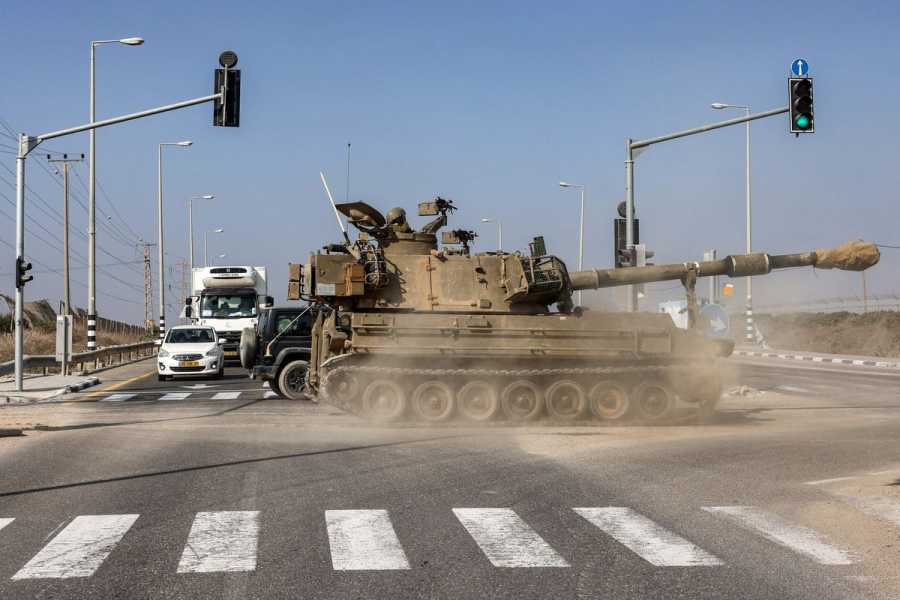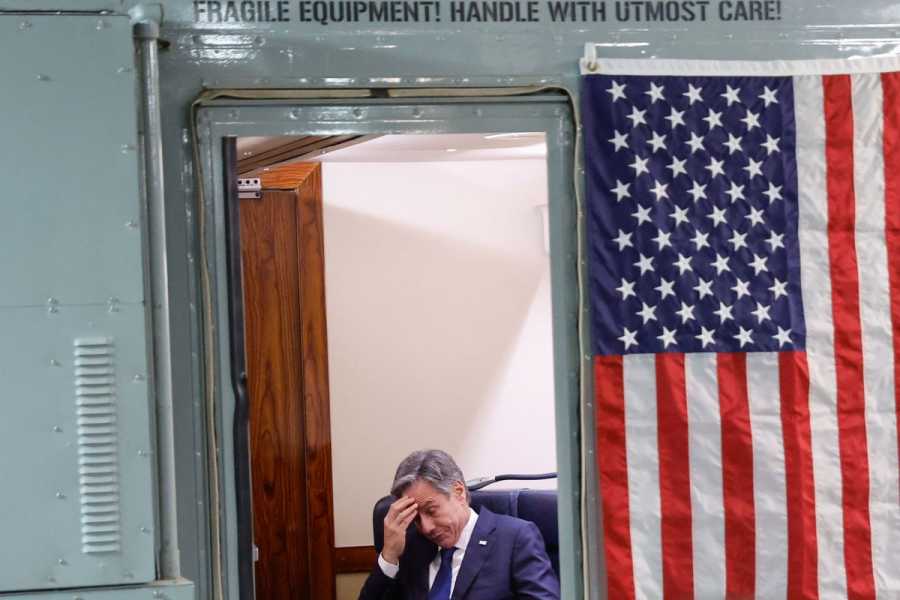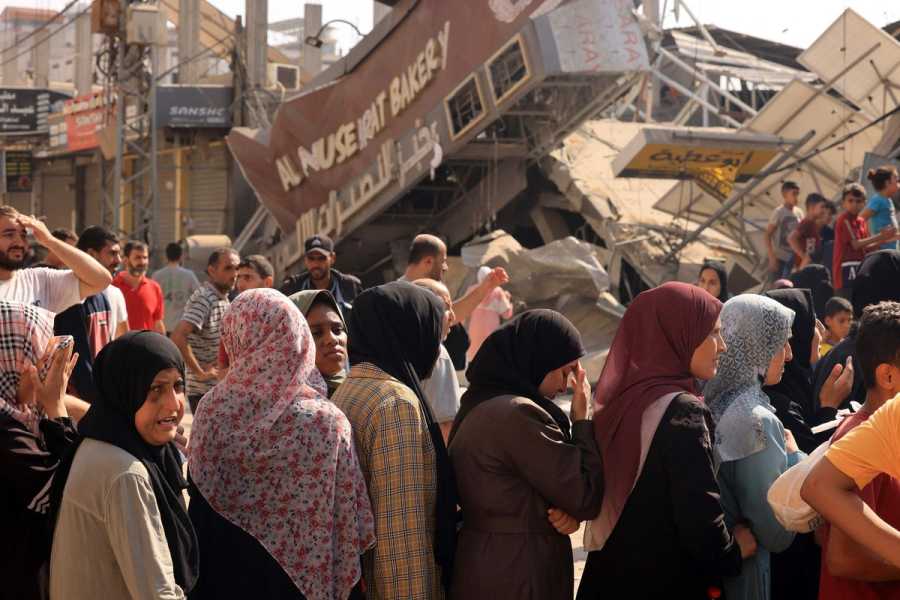What history can — and can’t — tell us about the hope for a Gaza ceasefire.

An Israeli army self-propelled artillery howitzer moves past waiting traffic while crossing a road along the border with the Gaza Strip in southern Israel on November 1, 2023 amid ongoing battles between Israeli forces and Hamas. Menahem Kahana/AFP via Getty Images Jonathan Guyer covers foreign policy, national security, and global affairs for Vox. From 2019 to 2021, he worked at the American Prospect, where as managing editor he reported on Biden’s and Trump’s foreign policy teams.
The last time that Israel and Hamas engaged in hostilities that had the potential to ignite a larger war was in May 2021. At the time, National Security Adviser Jake Sullivan flew to Cairo and worked with Egyptian officials to negotiate a ceasefire. He drew from his own experience: In November 2012, as an aide to Secretary of State Hillary Clinton, he and his Egyptian counterparts had locked in a ceasefire after a different outburst of conflict.
So I found it revealing about where this war currently stands, and how different it is from the past, when Clinton dismissed any possibility of a ceasefire while speaking last week at Rice University’s Baker Institute. “People who are calling for a ceasefire now do not understand Hamas. That is not possible,” she said. “It would be such a gift to Hamas, because they would spend whatever time there was a ceasefire in effect rebuilding their armaments, creating stronger positions to be able to fend off an eventual assault by the Israelis.”
Historically, these ceasefires have worked for both Israel and Hamas, until they haven’t.
But the previous logic of Israel-Hamas wars no longer holds after the October 7 attacks on Israel, in which 1,400 people were killed and 242 people were taken hostage. That has fundamentally altered Israel’s security thinking: It now wants to eliminate Hamas entirely. Israel’s existential catastrophe has changed its approach to security, as we’re seeing through its intensive bombardment of Gaza and its ongoing ground incursion, with more than 9,000 Palestinians killed, including 3,000 children.
“The technique before was to convince the Israelis that Hamas can be under control,” Nabeel Khoury, a career US diplomat focused on the Middle East who retired as a minister-counselor, told me. “Israelis are way beyond that. They want something much more radical than what happened in the past.”
The fact that nearly everyone powerful in the US is also rejecting a ceasefire now doesn’t mean one is impossible. What it shows is that Israel just doesn’t want one, period, and the US has largely followed Israel’s lead.
The old paradigm of ceasefires between Israel and Hamas appears to have been broken, but that doesn’t mean that the many examples of the two parties engaging in talks and upholding agreements are not relevant. Even with Israel locked in what it sees as an existential battle with Hamas, the door isn’t, and can’t be, totally closed to diplomacy.
There are lessons about who can exert pressure; who has the expertise to work with Hamas; how these talks happen behind closed doors; and, crucially, how the US can play a key role in Israel’s decision-making.
With Israeli Prime Minister Benjamin Netanyahu insisting Friday that Israel will continue its military operations in Gaza “with full force,” it seems that a ceasefire will only come from a US initiative. Biden hinted as much and discussed the need for a humanitarian “pause” and the release of hostages when interrupted by a protester at a Minnesota event on Wednesday, and the next day Secretary of State Antony Blinken traveled to the Middle East. As the death toll among Palestinians has grown, the Biden administration has continually readjusted its language with a recognition of the humanitarian catastrophe in Gaza and the need for a political process that would culminate in a Palestinian state.

Secretary of State Antony Blinken onboard a plane as he departs Israel from Tel Aviv en route to Jordan, amid the ongoing conflict between Israel and Hamas on November 3, 2023. Jonathan Ernst/POOL/AFP via Getty Images
But perhaps the most important lesson to take from those ceasefires past is that they were, in a certain sense, failures: They couldn’t hold in the long-term because they were not tied to a bigger political framework that could lead to a Palestinian state alongside Israel. They ultimately proved unsatisfactory both for the situation of Palestinians in Gaza, and throughout the occupied territories, and for Israel’s own sense of security. That they were ceasefires alone meant they wouldn’t lead to anything that could secure the future for Israelis and Palestinians.
However this immediate violence ends — Israel declaring victory, a ceasefire, or something else — ultimately the war will only be resolved by difficult diplomacy and US leadership toward a Palestinian state.
How previous Israel-Hamas wars have ended, briefly explained
Since 2007, Hamas and the state of Israel have existed in a “violent equilibrium,” as Tareq Baconi of the Palestinian research network Al-Shabaka describes it. That year, Hamas seized control of the Gaza Strip after winning the 2006 Palestinian elections; Israel then imposed a crippling blockade on the territory. That led to extreme rates of poverty in Gaza; over 60 percent of people need food assistance, and access to health care is extremely limited. About a quarter of Palestinians in Gaza, and nearly 80 percent of youth, are unemployed.
“What we see is every few years, or really every few months, a situation occurs where Hamas fires rockets at Israel, when the restrictions of the blockade become too stifling, and essentially force an escalation where a ceasefire is eventually negotiated, and Israel is forced to ease restrictions into the blockade,” Baconi said recently on The Dig podcast.
A review of the recent Israel-Hamas wars shows that after each conflict stopped, that violent equilibrium was restored. At times there were peace talks, but they were not really tied to a bigger political process that could lead to a larger settlement of the Israel-Palestine conflict.
Israel’s Operation Cast Lead in 2008-2009 lasted 22 days. In the conflict, 1,400 Palestinians, among them at least 759 civilians, were killed, as well as 10 Israeli soldiers and three civilians. Secretary of State Condoleezza Rice worked to secure a ceasefire. “We need urgently to conclude a ceasefire that can endure and that can bring real security,” she told the UN on January 6, 2009. “This would begin a period of true calm that includes an end to rocket, mortar, and other attacks on Israelis, and allows for the cessation of Israel’s military offensive.”

A Palestinian boy peers into the Awaja family’s tent in Beit Lahia, in the northern Gaza Strip, on December 27, 2009, one year after their home was destroyed in Israel’s offensive against the Gaza Strip. Mohammed Abed/AFP via Getty Images

People queue for bread in front of a bakery that was partially destroyed in an Israeli strike, in the Nuseirat refugee camp in the central Gaza Strip, on November 2, 2023, as battles continue between Israel and Hamas. Mahmud Hams/AFP via Getty Images
This all came on the eve of President Barack Obama coming into the White House. He initially prioritized talks between Israel and the Palestine Liberation Organization, and put limited pressure on Israel to halt the construction of new settlements in the occupied West Bank. Despite that, little progress was made.
That ceasefire held until November 2012, with an eight-day conflict between Israel and Hamas; 167 Palestinians and six Israelis died. Clinton was secretary of state, and Sullivan played a key role in negotiating a ceasefire.
That truce broke in the summer of 2014, when a 50-day war between Israel and Hamas left 2,251 Palestinians dead, among them 1,462 civilians, and 67 Israeli soldiers and six civilians. Talks between Israelis and Palestinians had collapsed the spring before and have not relaunched since.
Each time, the US and Egypt have played important roles in cementing these ceasefires, even as Egypt and Israel restricted movement in and out of the occupied territory of Gaza. Since the US designates Hamas a terrorist group, it depends on third parties for talks with the militant group. “Negotiating between Israel and Hamas has been one of the niche kind of activities that Egypt specialized in,” Ezzedine Choukri Fishere, a former Egyptian diplomat, told me. “For the last 16 years, the Egyptian policy on Gaza has been a stopgap — de-escalate.” In more recent years, Turkey and Qatar have also held indirect talks with Hamas.
When the Biden White House faced another Israel-Hamas conflict in May 2021, US officials followed the playbook from the two wars that happened under Obama — prevent UN Security Council resolutions and work the backchannel with Hamas. The war lasted 11 days in May 2021, killing 230 Palestinians and 12 Israelis. The lesson Biden took from the Obama years was that all clashes with Israel must happen in private if at all, that there should be no daylight between the countries, and that conflict between allies is detrimental to the point of being unbearable.
So Biden’s method to ending the May 2021 conflict was quiet diplomacy with Prime Minister Netanyahu. The US blocked United Nations resolutions and stood by Israel, to a point. Biden “held his tongue” when he learned that Netanyahu’s military operation had “no defined objective,” as journalist Franklin Foer recounts in his book The Last Politician. After four phone calls between the two leaders, Biden was blunt to Netanyahu: “Hey man, we’re out of runway here … It’s over.” And then it was.
What’s different this time
This Middle East war could last longer than any recent previous conflict between Israel and Hamas. The scope of Hamas’s attack, the ensuing Israeli bombardment and ground incursion, and the level of the death toll is already much more drastic than previous rounds of violence.
The understandable focus on the destruction of Gaza and the tremendous loss of human life there perhaps obscures what has really happened from an Israeli point of view. “I don’t think there’s enough appreciation of the impact of October 7,” Fishere, who is now a visiting professor at Dartmouth College, told me. “For Israel, this is a new moment. This is not a repetition.”
Netanyahu says Israel’s goals are the elimination of Hamas and the return of hostages.

240 chairs, one for each Israeli held hostage by Hamas in Gaza, are placed at the ‘’Hostages Square’’ outside the Art Museum of Tel Aviv, on November 03, 2023. Gili Yaari/NurPhoto via Getty Images
But it’s not at all clear how Hamas could be removed with force alone — and should it be, what party would govern Gaza. US and Israeli officials have floated trial balloons in unattributed quotes to the press that include a new Palestinian Authority, Egypt stepping in, or a multinational force, and Biden has urged Israel not to take over the territory.
None of those would be good options. Any day-after plan for Gaza would require some buy-in from Hamas leadership — an agreement that its military wing and affiliated forces like Islamic Jihad would drop their weapons.
This is the paradox: The ferocity of October 7 has convinced Israeli leadership that it must utterly destroy Hamas, yet there is little evidence it can achieve that goal. In the past, Israel was satisfied with damaging the militant group before settling into a ceasefire state. But this time, Israel is not seeking the kind of cessation of hostilities that defined the end to four previous rounds of conflict. “The only possible ceasefire would be a ceasefire that disarmed Hamas,” Fishere says. “And I don’t think anybody can offer that.”
But there is another difference to this war: Hamas is holding 242 hostages, a number that dwarfs previous instances of hostage-taking. That gives Hamas leverage, and pretty much precludes Israel from agreeing to unilaterally stop its assault on Gaza.
In public, there seems to be no path forward: Hamas has said that it won’t negotiate over the hostages until there is a ceasefire, and Israel seems to say it would only go for a ceasefire with unconditional release of hostages.
What has been floated is a temporary ceasefire — a situation where Hamas’s hostages are exchanged, in essence, for a respite from the fighting and, likely, the release of Palestinian prisoners.
The exact mechanics of such exchanges are closely held secrets. The Israeli peace activist Gershon Baskin worked directly with a Hamas interlocutor to secure the release of Gilad Shalit, who in 2011 was exchanged for 1,000 Palestinian prisoners and Hamas members. “Negotiating for the release of hostages may also be less popular this time around,” Baskin wrote in an opinion column for the New York Times earlier this month. The price for the hostages would be just as high as before.
Israel has a moral responsibility to bring home all of the hostages. Israel failed to provide security for them. The proposal: all of the hostages for all of the Palestinian prisoners is very difficult to accept but Israel must consider it & if yes, it has to be done quickly.
— Gershon Baskin جرشون باسكين (@gershonbaskin) October 30, 2023
Netanyahu says the Israeli military incursion will press Hamas to release the hostages. But for now, Israel’s ongoing bombardment of Gaza has seemingly not encouraged Hamas to release hostages. “My analysis is that this Israeli government has in the most cynical way simultaneously written off the lives of the hostages, while using them as political capital in convincing the world that no one can tell them what they can or can’t do in Gaza,” Lara Friedman, president of the Foundation for Middle East Peace, told me. “The hostages will be released despite the government of Israel, not because of it.”
A ceasefire — or more war
The Financial Times was the first international editorial page to call for a ceasefire. UNICEF, the World Health Organization, the World Food Program, the United Nations secretary general, and the Pope now have, too.
Israel categorically rejects these calls. Yet the composite picture is of dwindling international support for Israel’s military campaign, which appears to be putting some pressure on Biden. You can see it in the very gradual shift in action and tone from the administration. Vice President Kamala Harris called for “the urgent need to increase humanitarian aid to civilians in Gaza.” Blinken arrived in the Middle East and pushed Netanyahu to temporarily pause its military campaign to allow in humanitarian aid.
There is no easy way to secure a ceasefire. One is only likely to happen if the US and Israel together felt like enough Hamas leaders have been taken out and their military capabilities sufficiently immobilized, and that there is a chance to negotiate some kind of hostage exchange.
While the previously negotiated ceasefires have limited applicability, they do offer faint lessons. One: Third parties like Egypt, Qatar, and Turkey will be integral to the process.
Khoury, the former American diplomat who is now at the Arab Center Washington DC, says Qatar may have more power to influence Hamas than Egypt. Earlier this week, the head of the Mossad, Israel’s intelligence services, traveled to Doha. “If Israel and the US would give the Qataris a carte blanche, they can come up with something,” Khoury told me. “But the US and Israel will have to be ready to accept a continued role for Hamas in some capacity. They could say disarm Hamas. But if they wish to obliterate Hamas, Qatar cannot help with that.”
Two: The US has to play a major role behind the scenes. At some point, Biden’s team is going to spell out more clearly to the Israelis that the US is not going to countenance this anymore.
And, perhaps most importantly, three: There must be a clearer picture of what happens after any ceasefire.
“If there’s no political path to deal with the question of occupation, then whatever Israel will do now, regardless of how long it’s gonna take and how many people gonna kill, is not gonna resolve the issue,” Fishere told me. “It will come back and hit us again, at some point in the future, probably not too far.”
Sourse: vox.com